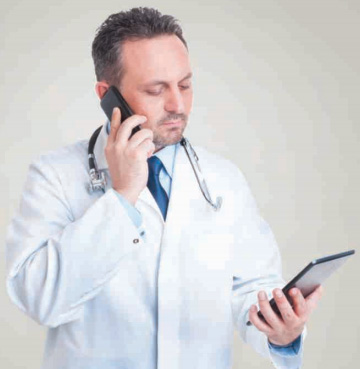Physician usage of smartphones for professional purposes increased from 68 percent in 2012 to 85 percent in 2015, according to Laura Vearrier, MD, clinical assistant professor in the College's Department of Emergency Medicine, who recently conducted a workshop, "The Ubiquitous SmartPhone and Professionalism." Most medical students and residents use smartphones in patient care settings as well. Yet little training has been done on how to use them professionally.

Distracted doctoring is similar to distracted driving. The rapid changing of attention between tasks interrupts your cognitive process.
"In a 2014 survey of medical students, only 9 percent reported that they had received feedback on how to conduct themselves professionally when using mobile technology in a clinical setting," says Vearrier, noting that physicians also need training in professional etiquette.
To be sure, smartphones offer many benefits in the clinical setting. They keep providers up to date with evolving medical knowledge and guidelines. Medical students can access their textbooks on their phones. Applications such as medication interaction calculators enhance physical examinations, and phone cameras allow consults to take place between providers in different locations. Overall, smartphones can contribute to better communication between physicians, which can lead to greater efficiency and accuracy in providing patient care.
But there is a downside as well. "One of the biggest downsides is that the personal devices can create a physical barrier between the provider and the patient," says Vearrier. "When patients see doctors using smartphones, they automatically think the doctor is on social media or texting for personal use rather than using clinical applications. However, most physicians and nurses use their personal devices for professional purposes, according to a 2012 survey.
"Patient perceptions are very important so it's vital to be transparent with patients about why you are using your phone," emphasizes Vearrier. "For example, share with patients that you are using an application to look up their medications to see if there are any interactions. Show them the app on your phone so they can understand the process."
Another downside is that phones are distractions. In addition to getting texts about patients, providers are also getting personal texts and calls and may be distracted by the many apps on their phones. This has led to the idea of "distracted doctoring," says Vearrier. "Distracted doctoring is a lot like distracted driving in that there are tasks that become automated — things you do every day in your career — and you are at risk for engaging in secondary activities," she explains.
"That's why everyone thinks they can text and drive, and despite education and statistics about the dangers of distracted driving, people still do it. Distracted doctoring is similar. It involves multitasking, which isn't so much performing two tasks at once, it's the rapid changing of attention between tasks. All these constant distractions interrupt your cognitive process and slow you down, as well as increase the risk of error."
Doctors, residents and medical students need to learn how to do their own triage of information that is constantly coming at them, according to Vearrier. They also need to learn how to properly integrate technology into patient care and into the physician-patient relationship so that the patient perception of mobile technology improves in the patient care setting.
One of the greatest clinical benefits of the smartphone — the camera — can also be a challenge. If a provider takes photos of a patient during a physical exam and shares them with consultants, the patient's privacy must be maintained at all times. "Providers need to be aware of where their photos are being stored and who has access to them to protect patient privacy," emphasizes Vearrier.
"Training is needed for everyone — physicians, medical students and residents," Vearrier says. "Smartphones give us huge potential to improve accuracy and streamline communication about our patients, but we have to be sure we're using them in the most professional way possible."